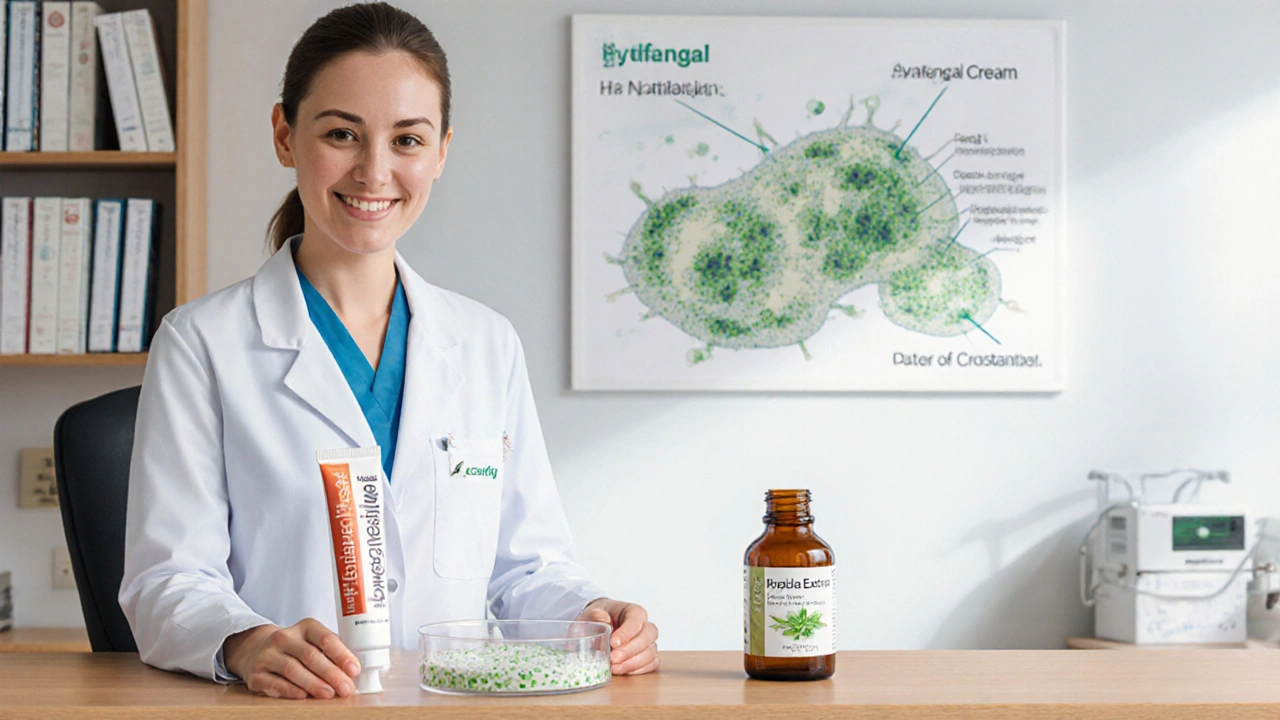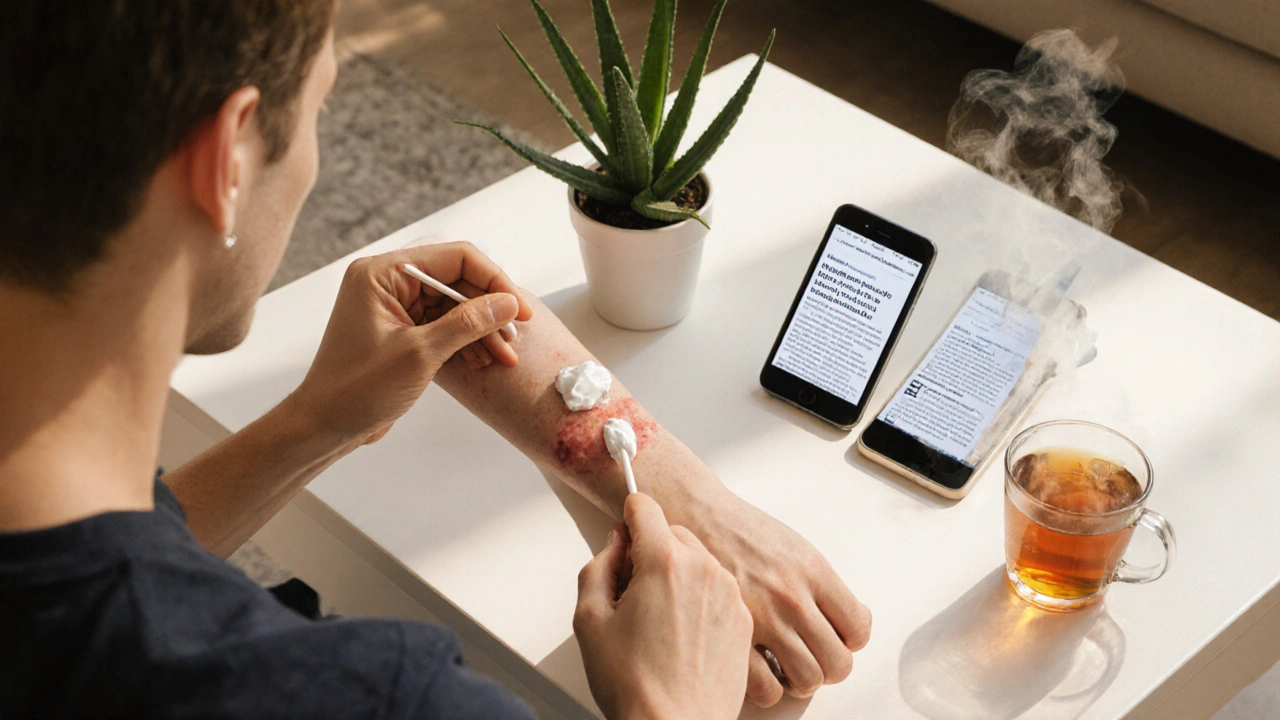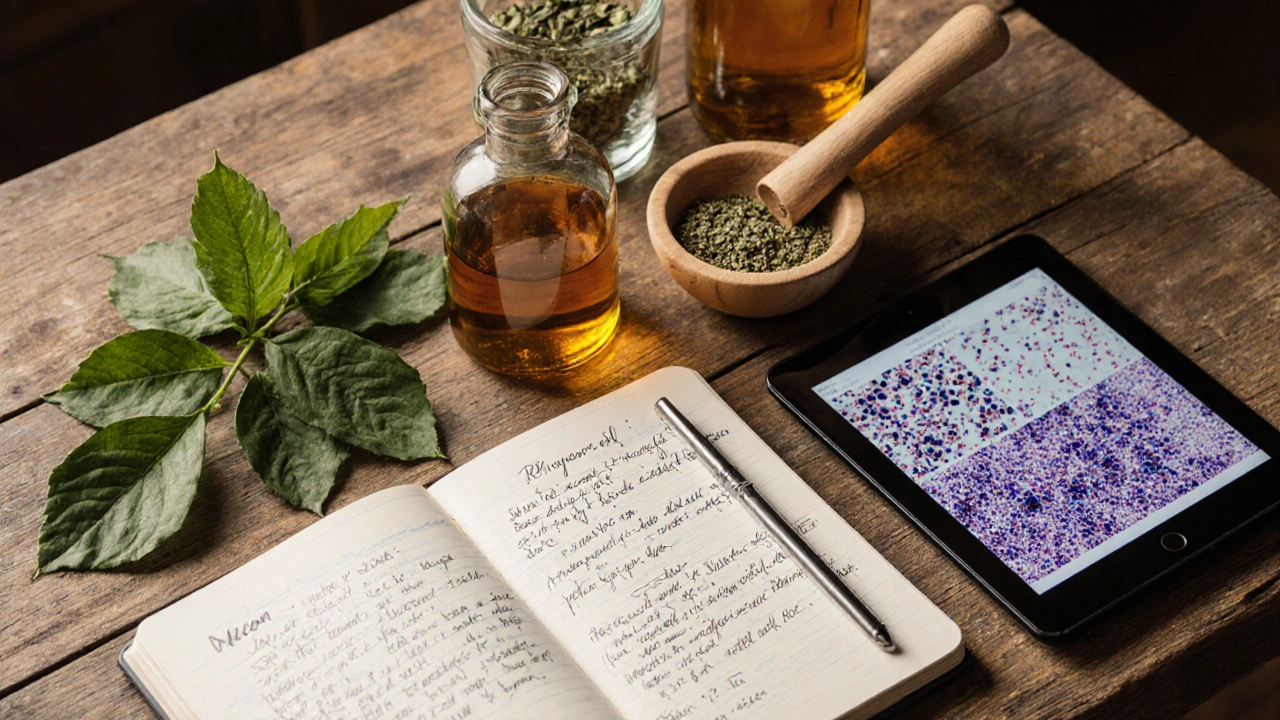TL;DR
- Ringworm is a fungal skin infection that usually clears with OTC antifungal creams.
- Some plant‑based oils (tea tree, oregano, coconut) show modest lab activity, but clinical proof is limited.
- Apple cider vinegar and garlic can help soothe itching, yet they don’t replace proper antifungal medication for a full cure.
- Safety matters: undiluted essential oils can burn skin; allergic reactions are possible.
- Best practice: start with a short course of proven antifungal cream, add a natural remedy for symptom relief only if the skin tolerates it.
When you hear natural remedies for ringworm, the first thought is often a quick, chemical‑free fix. The idea feels great-grab a bottle of oil from the pantry and say goodbye to the itchy ring. But does that work, or are you just chasing a myth? This article unpacks the science, walks through the most‑talked‑about home treatments, and tells you when to reach for a pharmacy‑shelf cream.
What Exactly Is Ringworm?
Ringworm is a superficial fungal infection caused by dermatophytes, a group of fungi that thrive on keratin-rich tissues such as skin, hair, and nails. It appears as a red, scaly patch with a clearer center, often itching intensely. Dermatophytes most commonly involved are Trichophyton rubrum, Trichophyton mentagrophytes, and Microsporum canis. The condition, medically termed tinea corporis when it affects the body, spreads via direct skin contact, contaminated objects, or pets.
Because the fungus lives on the outer skin layer, it’s usually confined to the epidermis and responds well to topical treatment. However, the infection can persist for weeks if untreated, and scratching can lead to secondary bacterial infection.
Conventional Treatments: How They Work
Over‑the‑counter (OTC) antifungal creams such as clotrimazole, miconazole, and terbinafine contain agents that disrupt the fungal cell membrane, essentially killing the organism. These medicines are backed by decades of clinical trials and typically clear the infection in 1-2 weeks when used as directed.
Prescription oral antifungals (e.g., terbinafine tablets) are reserved for extensive or stubborn cases. While effective, they carry a higher risk of liver‑related side effects, so they’re not the first line for most people.

Popular Natural Remedies and the Evidence Behind Them
Below are the most‑cited home treatments. For each, we note how it’s used, what lab or clinical data exist, and practical pros and cons.
Tea Tree Oil
Tea tree oil is an essential oil extracted from Melaleuca alternifolia leaves. Its main active component, terpinen-4-ol, shows antifungal activity against dermatophytes in vitro.
- How to use: Dilute 1-2 drops in a carrier oil (e.g., coconut or jojoba) and apply twice daily to the affected area.
- Evidence: Small pilot studies report faster symptom relief when combined with standard creams, but no large‑scale trials prove it works alone.
- Pros: Pleasant scent, antibacterial properties.
- Cons: Can cause skin irritation or allergic dermatitis if not diluted properly.
Oregano Oil
Oregano oil contains carvacrol, a compound with documented antifungal effects against Trichophyton species in laboratory settings.
- How to use: Mix 1 drop with a teaspoon of carrier oil, apply twice a day.
- Evidence: Laboratory data is strong; clinical evidence is anecdotal.
- Pros: Potent, may reduce itching.
- Cons: Strong aroma, higher risk of burning sensation.
Coconut Oil
Coconut oil is rich in medium‑chain fatty acids, especially lauric acid, which can damage fungal cell membranes.
- How to use: Apply a thin layer to the lesion 2-3 times daily; can be used alone or as a carrier for essential oils.
- Evidence: A 2014 randomized trial in India found coconut oil reduced lesion size faster than plain moisturizer, but not faster than standard antifungal cream.
- Pros: Widely available, moisturizes skin.
- Cons: May leave a greasy residue; limited potency against severe infections.
Apple Cider Vinegar (ACV)
Apple cider vinegar is a fermented liquid with a pH around 3, creating an acidic environment that can inhibit fungal growth.
- How to use: Dilute 1 part ACV with 3 parts water, soak a clean cloth, and dab onto the rash twice daily.
- Evidence: No robust clinical trials; small case reports note reduced itching.
- Pros: Cheap, easy to find.
- Cons: Potential skin irritation, especially on broken skin.
Garlic
Garlic (Allium sativum) contains allicin, a sulfur‑rich compound with antifungal activity.
- How to use: Crush a clove, mix with a little olive oil, apply as a paste for 20 minutes, then rinse. Do once daily.
- Evidence: Lab studies show allicin kills dermatophytes; human data are limited and mixed.
- Pros: Natural, may boost immunity.
- Cons: Strong odor, can cause burning.
Head‑to‑Head: Natural vs. Conventional Options
| Remedy | Active Component | Typical Use | Evidence Level | Pros | Cons |
|---|---|---|---|---|---|
| Tea Tree Oil | Terpinen‑4‑ol | Diluted topical 2×/day | Small clinical pilots | Antibacterial, pleasant scent | Potential skin irritation |
| Oregano Oil | Carvacrol | Diluted topical 2×/day | Laboratory only | Strong antifungal action | Strong smell, possible burning |
| Coconut Oil | Lauric acid | Direct application 2-3×/day | One modest RCT | Moisturizes, readily available | Limited potency |
| Apple Cider Vinegar | Acetic acid (pH ~3) | Diluted soak twice daily | Case reports | Cheap, easy to use | Irritation on open skin |
| Garlic | Allicin | Paste once daily | Lab studies | Immune boost potential | Odor, burns if left too long |
| Clotrimazole Cream (OTC) | Clotrimazole | Apply 2×/day for 2‑4 weeks | Large RCTs, FDA‑approved | High cure rate, well‑tolerated | May cause mild itching |
How to Choose a Safe and Effective Approach
Here’s a quick checklist you can print or screenshot before you head to the kitchen or pharmacy:
- Confirm the diagnosis. If the rash is spreading quickly, isn’t improving after a week of home care, or you have a weakened immune system, see a clinician.
- Start with a proven antifungal. An OTC cream like clotrimazole offers the highest odds of a full cure within two weeks.
- Add a natural remedy for symptom relief only. Choose one low‑risk option-e.g., diluted tea tree oil or coconut oil-after you’ve begun the cream.
- Watch for side effects. Redness, burning, or worsening itchiness means stop the natural product immediately.
- Maintain hygiene. Wash the area gently, keep it dry, and change socks or clothing daily.
If you decide to forego OTC medication entirely, be prepared for a longer healing timeline-often 3-6 weeks or more-and have a low threshold for switching to a medical product if progress stalls.

Frequently Asked Questions
Can I cure ringworm only with essential oils?
Essential oils like tea tree or oregano can reduce fungal growth in the lab, but they rarely eradicate an infection on their own. Most experts recommend coupling them with a proven antifungal cream for reliable results.
Is apple cider vinegar safe for kids?
Diluted ACV (1:3 ratio) is generally gentle enough for children, but you should avoid applying it to open sores. Test a small patch first and stop if any stinging occurs.
How long should I use a natural remedy before expecting results?
Most users notice reduced itching within a few days, but visible clearing of the ring can take 2-4 weeks. If there’s no improvement after three weeks, switch to an OTC antifungal.
Can ringworm spread to other parts of my body?
Yes. Scratching can transfer spores to nearby skin, and items like towels or clothing can spread it to other people. Keep the area clean, avoid sharing personal items, and wash linens daily in hot water.
Do I need a prescription for severe ringworm?
If the infection covers large areas, involves the scalp, or doesn’t respond to OTC creams after two weeks, a doctor may prescribe oral antifungals. These work systemically and are more potent but require monitoring.
Bottom line: natural remedies can soothe symptoms, but they shouldn’t replace a clinically proven antifungal unless you’re dealing with a very mild case and are comfortable monitoring progress closely. When in doubt, a short course of an OTC cream is the fastest route to clear skin.





Narayan Iyer
September 28, 2025 AT 09:43Hey fam let’s talk ringworm real quick – it’s basically a fungal party on your skin and the science says you need a proper antifungal to shut it down. Using tea tree oil or oregano might give you a buzz of extra help but don’t expect it to be a solo hero. Dilute those oils or you’ll end up with a burn that feels like a bad mixtape. If you’re into natural stuff, pair it with an OTC cream and you’ll keep the vibe inclusive and safe. Remember, the goal is clear skin not just a cool story for the group chat.
Amanda Jennings
September 28, 2025 AT 11:06Go for the proven cream first and you’ll be back to feeling awesome in no time.
alex cristobal roque
September 28, 2025 AT 12:30Alright, let’s break this down step by step because the details matter when you’re juggling home remedies and pharmacy staples. First off, the fungal culprit in ringworm thrives on keratin, so any treatment has to reach that outer layer effectively. Over‑the‑counter creams like clotrimazole create a hostile environment for the fungus by disrupting its cell membrane, and that’s why they clear up infections in about one to two weeks when used as directed. Now, when you toss in a natural oil, you’re essentially adding a supplementary attack that might ease itching or give a slight antimicrobial edge, but it’s not a replacement for the main pharmacological punch. Take tea tree oil, for example – its component terpinen‑4‑ol has shown activity in petri dishes, yet the concentrations needed to mirror that in real life are tricky to achieve without irritating the skin. If you decide to use it, always dilute it in a carrier like coconut oil; a common ratio is one drop of essential oil to a teaspoon of carrier, applied twice daily. Oregano oil follows a similar pattern with carvacrol, a potent compound that can knock out dermatophytes in the lab, but again the smell is intense and skin sensitivity is a real risk if you go full strength. Coconut oil, on the other hand, is a gentler option that not only supplies lauric acid with antifungal properties but also keeps the area moisturized, which can prevent cracking that would otherwise let the fungus spread. A small randomized trial in India even hinted that coconut oil might speed up lesion shrinkage compared to a plain moisturizer, though it still lagged behind standard creams. Apple cider vinegar creates an acidic surface that’s unfriendly to fungi, but the acidity can sting, especially if you have any micro‑abrasions, so always dilute it at least 1:3 with water. Garlic paste brings allicin into the mix, and while allicin is a formidable antifungal agent in the lab, the strong odor and potential for burning make it a less popular choice for day‑to‑day use. The common thread through all these natural options is that they can serve as adjuncts for comfort – they might calm the itch, reduce redness, or simply make you feel like you’re doing something proactive – but they rarely, if ever, replace the efficacy of a proper antifungal cream. In practice, the safest and fastest route is to start with a thin layer of clotrimazole or miconazole, let it do the heavy lifting, and then sprinkle in a diluted essential oil or a dollop of coconut oil if your skin tolerates it. Keep an eye on the region; if you notice increased redness, swelling, or the rash spreading beyond the original border, that’s a red flag to seek professional medical advice. Also, remember hygiene: wash the area gently, dry it thoroughly, and avoid sharing towels or clothing until the infection clears. Lastly, patience is key – even with the best treatments, stubborn spots can linger a bit longer, but consistent application will usually see improvement within two weeks. So bottom line: use the science‑backed cream as your primary weapon, and let the natural remedies be your supportive sidekicks.
Matthew Holmes
September 28, 2025 AT 14:10They don’t want you to know the truth about these “natural” cures the pharma giants are hiding behind the curtain it’s all a smokescreen to keep you buying pricey meds
Patrick Price
September 28, 2025 AT 16:23Yo i heard u tried that garlic paste thing i gotta say its kinda weird you always mess with weird stuff anywhats how’s your skin feeling after all that oil i bet you’re sweating alot also i think you should try a little bit of honey it’s like super soothing trust me i read it on a forum last night
Travis Evans
September 28, 2025 AT 17:30Hey there, you’re doing great mixing the cream with a splash of coconut oil – that combo is like fireworks for your skin’s comfort while the real work gets done. Keep it up and you’ll be rocking clear skin before you know it.
Jessica Hakizimana
September 28, 2025 AT 20:00It’s awesome that you’re exploring options – the fact that you care enough to research tea tree oil or ACV shows you’re already ahead of the game. Remember that any natural add‑on is just a sidekick, the real hero is that antifungal cream you’ve got on hand. If you notice the itch calming down, that’s a good sign the skin’s healing. And even if the ring looks a bit stubborn at first, patience and consistency will win the day. Stay positive, keep the routine, and celebrate the small wins – each day without spreading is a victory.
peter derks
September 28, 2025 AT 20:50Stick with the schedule, apply the medication twice daily, and add a thin layer of diluted oil only if your skin feels tolerable; that’s the safest path forward.
Sarah DeMaranville
September 28, 2025 AT 22:46While the mainstream touts OTC creams as the ultimate solution the nuanced reality is that the phytochemical synergy in certain essential oils can rival synthetic agents if applied with precision
Edward Leger
September 28, 2025 AT 23:20One might consider the fungal infection not merely as a medical nuisance but as a reminder of the delicate balance our bodies maintain with the microscopic world, prompting reflection on how external interventions reshape that equilibrium.
Keyla Garcia
September 29, 2025 AT 02:23OMG the ringworm drama is real 😱 I mean, who thought a tiny fungus could cause such a freakout 🤯 But seriously, if you’re slathering on tea tree oil and feeling like a wizard 🎩 just remember the cream is still the real MVP 🏆 Stay safe and keep that skin glowing ✨
Harshal Sanghavi
September 29, 2025 AT 03:05Oh sure, just dab that apple cider vinegar on everything and you’ll be cured in a week, said no dermatologist ever 🙄. Seriously though, a little ACV can calm itch but don’t skip the proven cream unless you love waiting forever.
Duke Gavrilovic
September 29, 2025 AT 04:28Dear reader, while the discourse around natural remedies often oscillates between anecdotal enthusiasm and empirical skepticism, it remains essential to prioritize clinically validated treatments-namely, the over‑the‑counter antifungal creams-before exploring adjunctive botanical options. That said, a judicious application of diluted essential oil can be an acceptable supportive measure provided skin tolerance is confirmed.
Abby VanSickle
September 29, 2025 AT 04:53It is imperative that you do not disregard the established efficacy of antifungal pharmacotherapy in favor of unproven home concoctions; such negligence can prolong infection, increase discomfort, and potentially lead to secondary complications, which is unacceptable.